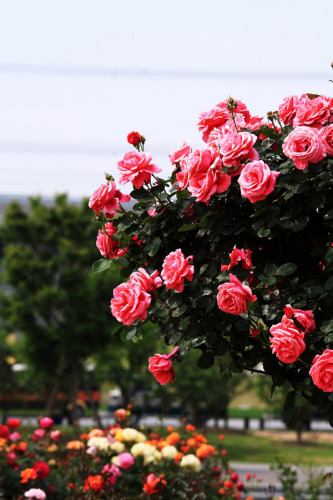
Rosa chinensis in bloom. (Photo provided to chinadaily.com.cn)
Breakthrough could lead to brighter, more scented blooms
Gardeners could soon be growing genetically engineered roses of new sizes, colors and scents after scientists from Europe and China sequenced the flower's genome for the first time.
A team of geneticists from the United Kingdom, France, Germany, Huazhong Agricultural University in Wuhan and the Chinese Academy of Agricultural Sciences in Beijing have successfully mapped the 36,377 genes that make up the Chinese rose species Rosa chinensis, commonly known as Old Blush.
Their research has been published in the journal Nature, and the breakthrough means that researchers will now be able to pinpoint genes that control specific traits, opening the door for future strains of genetically engineered roses that are pest-resistant, last longer in the vase, and have a wider diversity of scents and colors.
"The rose is one of the most important flowers in the world," said Mohammed Bendahmane, a geneticist from ENS Lyon university and lead author on the study. "It has a huge capacity of usage - as a garden flower, as cut flowers, for production of oils for cosmetics and medicinal purposes - it's a really important species."
Roses are the best sellers in the international cut flower industry, which is worth around $20 billion annually. Plant geneticist Antoine Larrieu, from Leeds University, one of the report's co-authors, said now the genome has been mapped, editing tools such as CRISPR/Cas9 could be used to create new strains of roses.
"CRISPR has been used in different plants species like tomato, wheat, rice, and it works really well, we know that it can make very precise modifications in the genome," Larrieu said. "It has not been used on roses yet, but now we have the reference sequence, it's just a question of doing it and going through a period of trial and error."
In roses, Larrieu explained, there is an inverse relationship between scent and color – meaning hybrids with a vivid color usually do not have a potent scent, and vice versa. He said gene editing could potentially resolve this, leading to "very flashy roses that have a very strong scent".
Rosa chinensis was selected for study, said Bendahmane, because it is one of the original parent roses of most modern varieties. Around 10 species of roses were introduced to Europe in the 18th century, from which around 40,000 species have since been bred.
"Rosa chinensis … was brought to Europe from China by French and British missionaries," he said. "By sequencing the parents, we can understand the composition of modern roses."
Jennifer Potter, horticultural historian and author of The Rose: A True History, said that Chinese people were among the first to domesticate roses.
"Chinese roses came into Europe and they brought wonderful new qualities - they had brighter colors, wonderful shiny leaves, a delicate scent, and petals like silk rather than heavy damask," Potter said.
"And they were recurrent bloomers - that is what was so precious about the Chinese roses. People fell in love with them, they had a massive impact on rose breeding."


















































